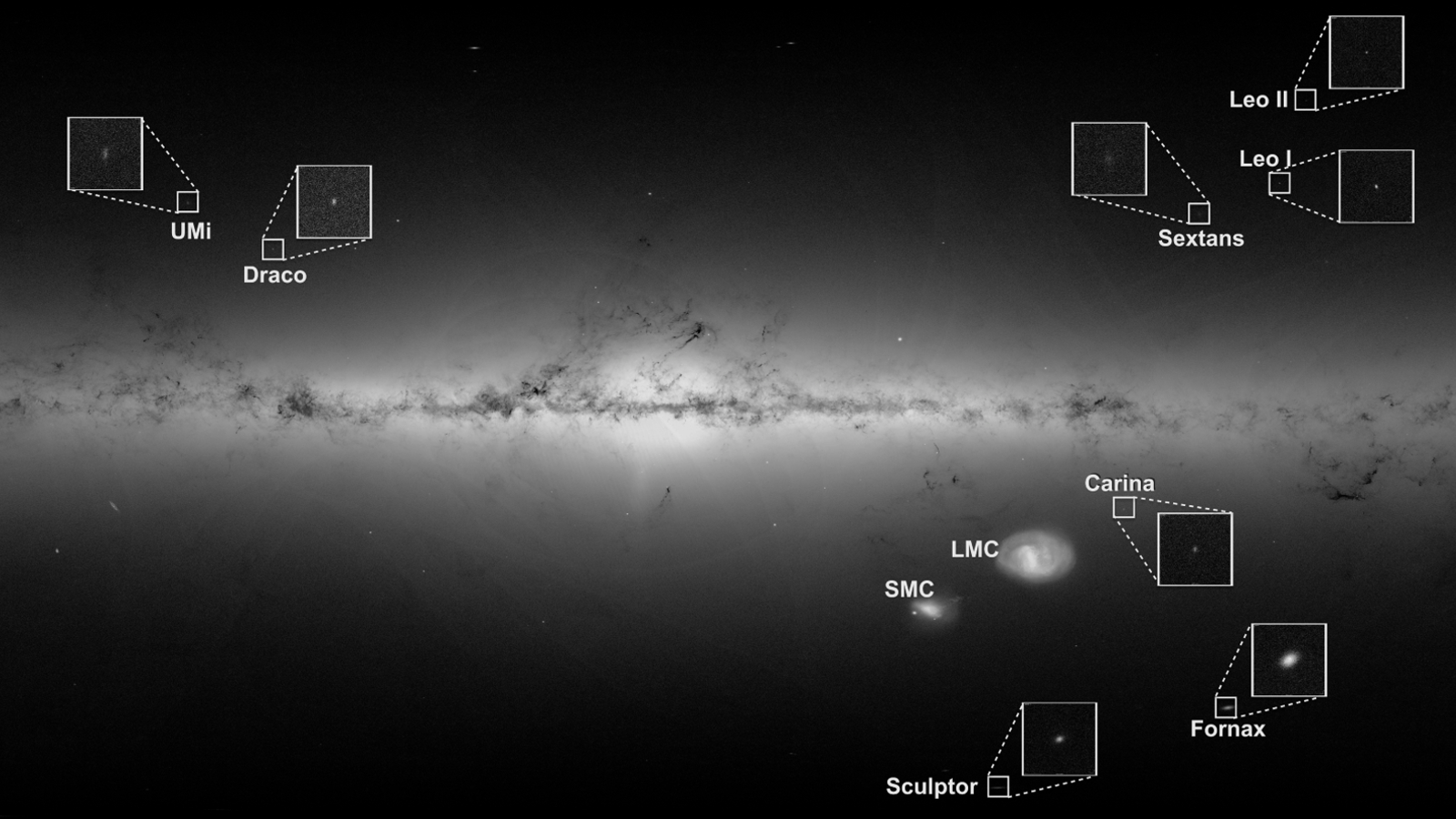The Milky Way may be surrounded by 'too many' mini galaxies, new discoveries reveal
Astronomers have just discovered two dwarf galaxy candidates orbiting our galaxy. The orientation of these entities suggests there could be up to 500 similar stellar clusters circling the Milky Way, which is more than double previous estimates.

Astronomers have discovered a previously unknown pair of potential satellite galaxies orbiting the Milky Way. The location of these dwarf galaxies suggests that hundreds of other unknown mini-galaxies could be hiding around us — potentially challenging our understanding of the galaxy's edges.
A satellite galaxy is a clump of stars, either in a circular blob or a halo-like shape, that orbit the Milky Way independently from the rest of the galaxy. Our galaxy's largest-known satellite is the Large Magellanic Cloud, which holds around 30 billion stars and can be viewed with the naked eye. Other known satellites only contain a few hundred thousand or a couple of million stars.
A 2020 census of known satellite galaxies suggests scientists have found a maximum of around 60 satellite galaxies orbiting the Milky Way. However, there is some uncertainty about the true number of satellite galaxies, largely because scientists disagree over how large these star clusters should be and how far they should lie from the galactic center to be counted as true satellites, according to NASA.
Related: The Milky Way will be visible without a telescope this summer. Here are the key nights to watch for.
But most astronomers agree that there should be many more, currently unknown, satellite galaxies out there. Based on our current understanding of dark matter — which doesn't react with light but interacts gravitationally with visible matter and makes up around 27% of the universe's mass — researchers have long assumed that the Milky Way should have around 220 satellite galaxies. Our inability to spot many more of these is often referred to as the "missing satellites problem."
In a new study, published June 8 in the journal Publications of the Astronomical Society of Japan, researchers discovered two new potential satellite galaxies, Sextans II and Virgo III. The satellites are located around 411,000 and 492,000 light-years from Earth respectively and are likely both ultra-compact dwarf galaxies (UCDs) — collections of old stars clumped tightly together, making them brighter than other satellite galaxies.
However, the discoveries do not help solve the missing satellites problem. Instead, the location and orientation of these potential satellites hints that there are even more satellite galaxies than scientists initially realized. This raises a new problem, which researchers have dubbed the "too many satellites problem."
Get the world’s most fascinating discoveries delivered straight to your inbox.
Related: Does the Milky Way orbit anything?
Researchers discovered the UCDs using the Hyper Suprime-Cam (HSC) attached to Japan's Subaru Telescope at Mauna Kea Observatories in Hawaii. This instrument has spent the last few years searching a region of space around 33 light-years across. Based on the estimated 220 satellite galaxies postulated by the missing satellites problem, an area of this size should have around four satellite galaxies on average, Universe Today recently reported.
However, the latest discoveries bring the total number of satellites found by HSC in this area to nine. If this concentration of satellites is consistent around the Milky Way, it would mean that there could be at least 500 satellite galaxies around the Milky Way, researchers wrote in a statement.
In the past, scientists have proposed multiple solutions to the missing satellites problem, including that some satellite galaxies are hiding behind larger satellites and that others are so diffuse they are almost impossible to detect with current technology. However, these factors are unlikely to be able to explain an overabundance of stars, leaving scientists with no real way to explain the new results.
"The next step is to use a more powerful telescope that captures a wider view of the sky," study co-author Masahi Chiba, an astronomer at Tohoku University in Japan, said in the statement. This should help clarify how common satellite galaxies really are, he added.
One such telescope is the upcoming Vera C. Rubin Observatory — a state-of-the-art facility equipped with the world's largest digital camera, which is expected to come online in 2025, Chiba said. "I hope that many new satellite galaxies will be discovered."

Harry is a U.K.-based senior staff writer at Live Science. He studied marine biology at the University of Exeter before training to become a journalist. He covers a wide range of topics including space exploration, planetary science, space weather, climate change, animal behavior and paleontology. His recent work on the solar maximum won "best space submission" at the 2024 Aerospace Media Awards and was shortlisted in the "top scoop" category at the NCTJ Awards for Excellence in 2023. He also writes Live Science's weekly Earth from space series.



